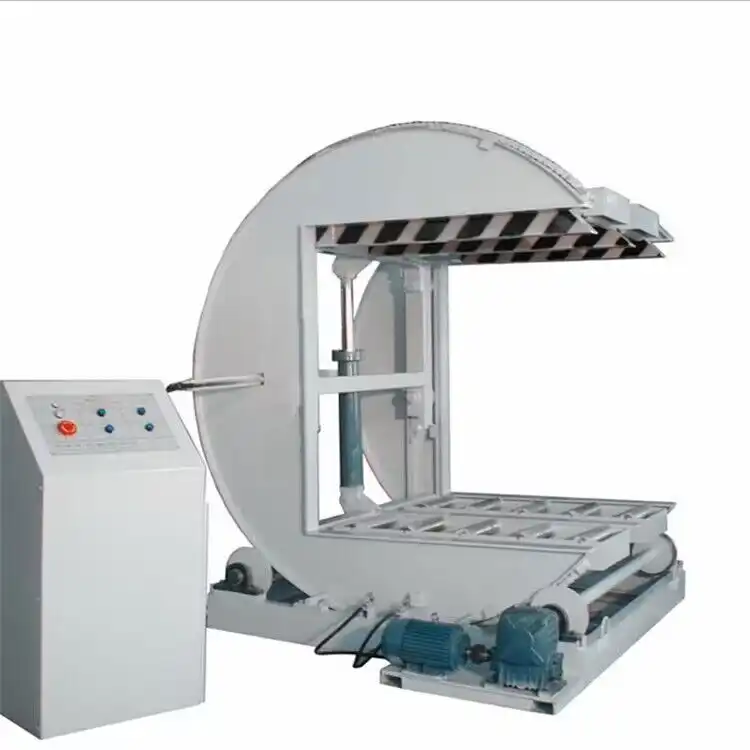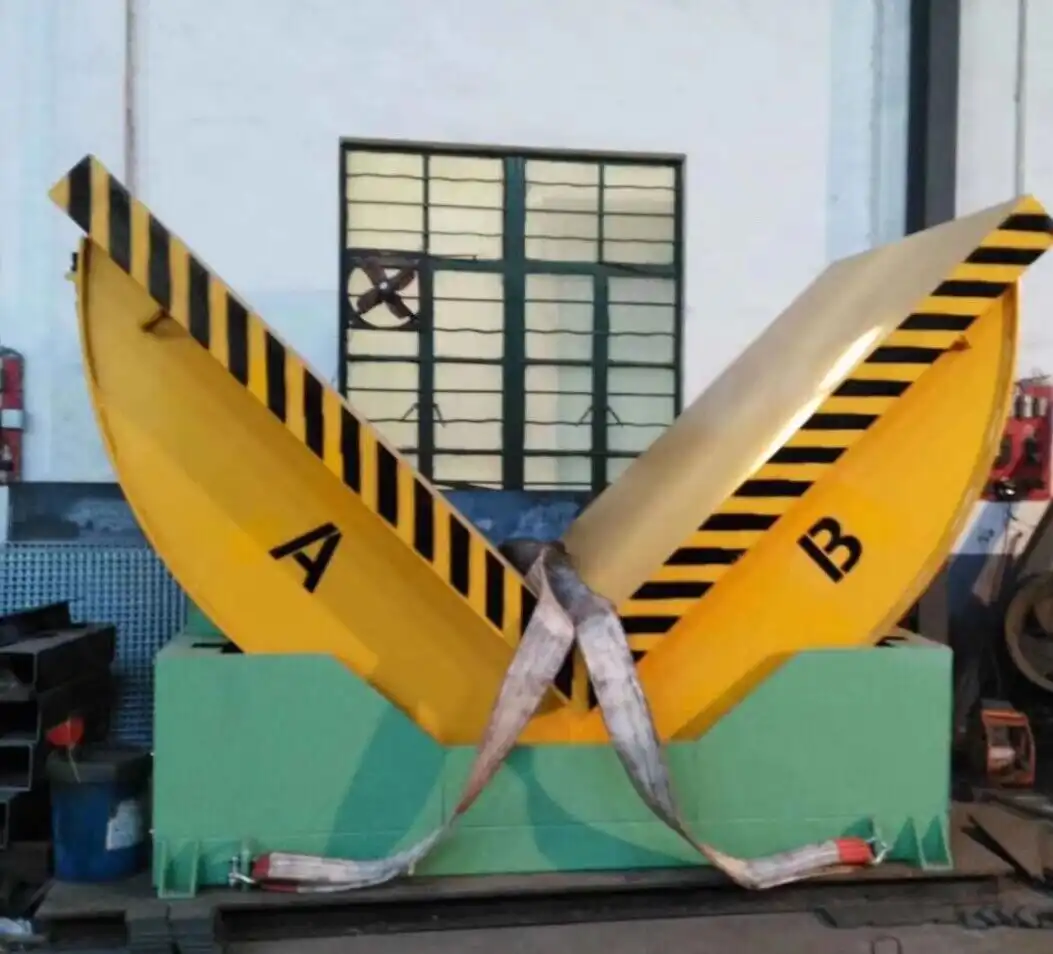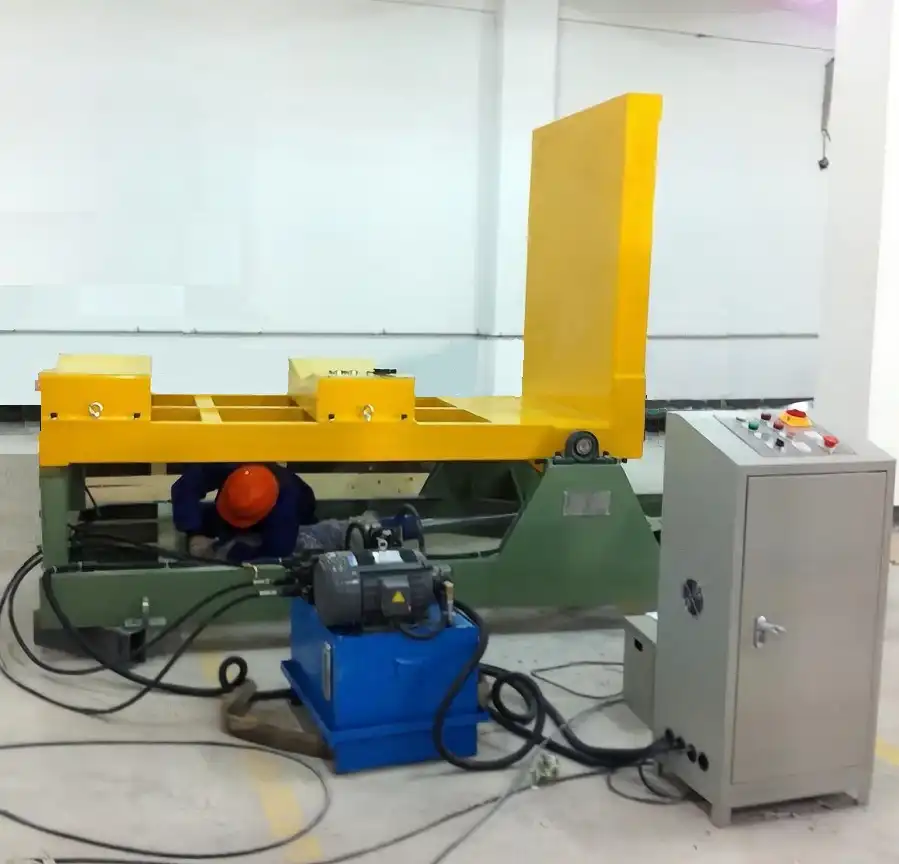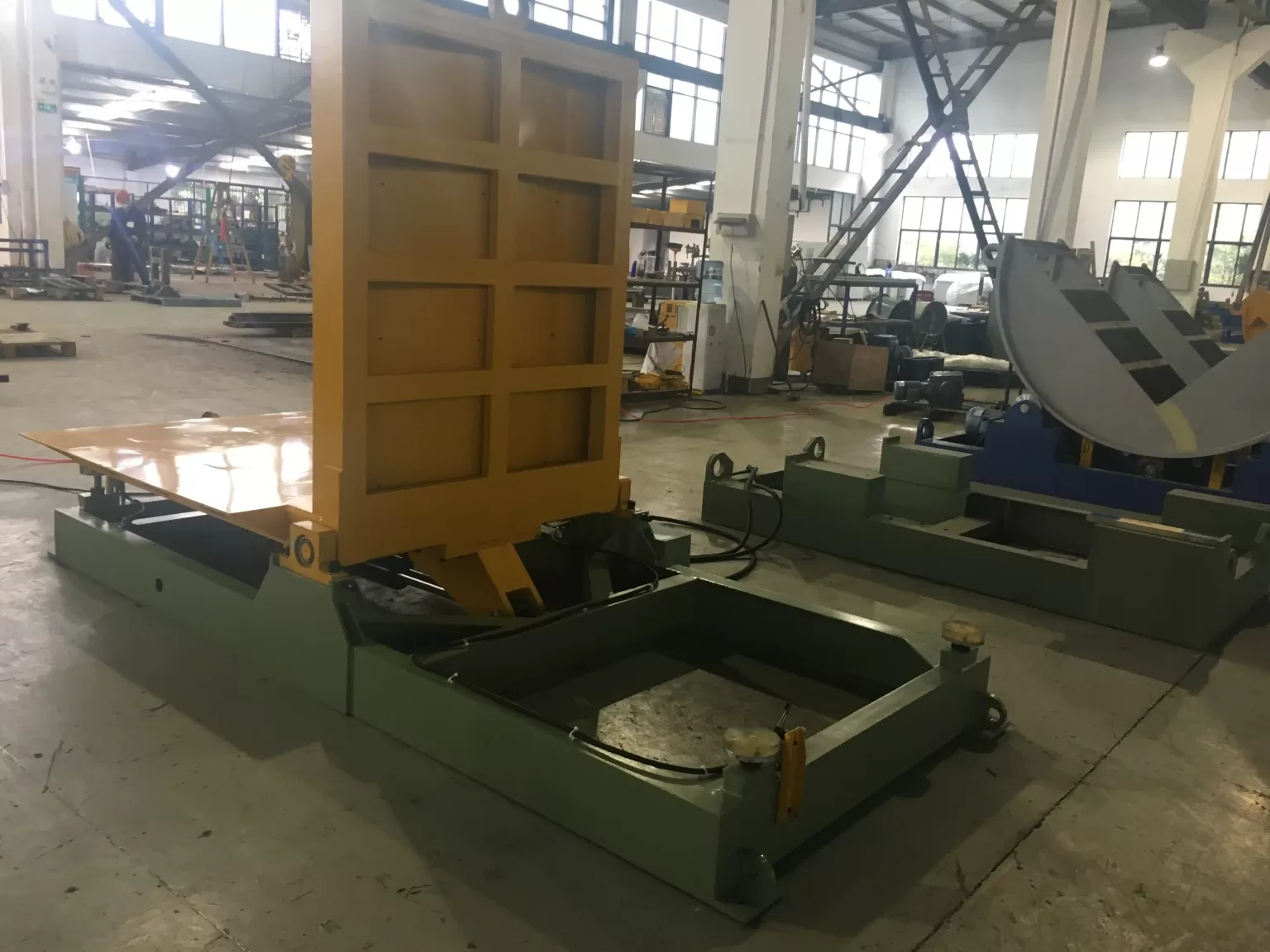Upender Machine Total Cost: Lease or Buy—Which Lowers Your TCO?
As a steel mill owner, every equipment decision you make directly impacts your bottom line. You are constantly looking at the numbers, trying to balance high performance with controlled costs. The upender machine, a critical piece of equipment for handling coils, presents a common but complex question: is it better to lease or to buy? This decision feels like a tug-of-war between a large, one-time capital expense and a long-term series of operational payments. The wrong choice can lock you into years of inefficiency and hidden costs, draining your resources and hindering your ability to invest in other critical areas like energy efficiency or digital upgrades.
Whether you should lease or buy an upender machine to lower your Total Cost of Ownership (TCO) depends on your specific financial situation and operational needs. Buying is typically more cost-effective in the long run for high-volume, stable operations, as you build equity and have full control. Leasing is better for preserving capital, managing short-term projects, or if you need the flexibility to upgrade technology frequently.

I've walked in your shoes. I started as an engineer on the factory floor and eventually built my own packing machine factory. I’ve made these same calculations countless times, both for my own operations and for my clients. The decision isn't just about the initial price tag. It’s about understanding the full, long-term financial picture—the Total Cost of Ownership. Let’s break down the key factors together, so you can make a choice that strengthens your business, not just for today, but for years to come.
How Does the Initial Investment Impact Your Decision to Lease or Buy?
You have ambitious goals for your plant. You want to reduce energy consumption, push for digitalization, and keep your production lines running smoothly. But every one of these goals requires capital. A new upender machine represents a significant investment, and you're worried that tying up a large amount of cash will slow down progress in other vital areas. This pressure to allocate funds wisely makes the initial financial impact of your decision incredibly important.
Buying an upender machine requires a substantial upfront capital expenditure (CapEx), which affects your balance sheet and cash reserves immediately. In contrast, leasing converts the cost into a predictable, lower monthly operational expense (OpEx), freeing up your capital for other strategic investments like plant upgrades or technology adoption.

Dive Deeper: Capital Expenditure vs. Operational Expenditure
Understanding the difference between CapEx and OpEx is fundamental for a CEO like you, who is responsible for the long-term financial health of the company. It’s not just an accounting detail; it’s a strategic choice.
The Financial Impact of Buying (CapEx)
When you buy an upender, it becomes an asset on your company's balance sheet. This means a large, one-time cash outflow. For a business owner focused on growth and managing large-scale operations, this can be a major hurdle. That cash could be used to fund a new energy recovery system or to pilot an IoT sensor program on an older, more critical production line.
Furthermore, an owned asset depreciates over time. While depreciation can offer tax benefits, it also represents a gradual decline in the asset's book value. As an experienced owner, you know that the true value is in its productive capacity, but from a purely financial standpoint, it’s a depreciating asset. I remember a client in Monterrey who decided to purchase three large upenders at once. It was the right move for their high, steady volume, but it delayed their planned conveyor system upgrade by 18 months because their capital budget was maxed out. They made it work, but it was a trade-off that impacted their material flow efficiency during that time.
The Cash Flow Advantage of Leasing (OpEx)
Leasing flips the script entirely. Instead of a large capital purchase, you have a fixed monthly payment. This is an operational expense, just like electricity or salaries. It doesn't hit your capital budget, leaving you with more liquid cash to pursue those strategic goals you've set, like lowering energy costs by 10% or investing in a new MES platform.
This predictability is a huge advantage in the volatile steel industry. When your input costs, like energy, are fluctuating, having predictable equipment costs helps stabilize your budget. You can forecast your expenses with much greater accuracy. The lease payments are also typically fully tax-deductible as a business expense, which can offer a more straightforward tax advantage than depreciation schedules.
Here is a simple breakdown:
| Feature | Buying (CapEx) | Leasing (OpEx) |
|---|---|---|
| Initial Cost | High, one-time payment | Low, monthly payments |
| Cash Flow Impact | Significant immediate reduction | Minimal, predictable impact |
| Balance Sheet | Appears as a long-term asset | Appears as an operating expense |
| Budgeting | Capital Budget (CapEx) | Operating Budget (OpEx) |
| Tax Implication | Depreciation over asset life | Payments are fully deductible |
The choice between CapEx and OpEx is a strategic one. If your mill is generating strong, stable cash flow and you plan to use the machine for over a decade, buying and absorbing the CapEx hit might offer the lowest TCO. But if preserving capital for technology and efficiency projects is your top priority, the OpEx model of leasing is extremely compelling.
What Are the Long-Term Maintenance and Operational Costs of Buying Versus Leasing?
Your goal of achieving 95% equipment uptime is ambitious and necessary. You know that a broken-down machine is more than just an inconvenience; it's a direct hit to your revenue. With some of your key equipment already over 15 years old, you've experienced the pain of rising failure rates and the scramble to find parts and technicians. You worry that a new upender, whether bought or leased, could become another maintenance headache if you don't plan for its entire lifecycle.
When you buy an upender machine, you are fully responsible for all maintenance, repairs, and spare parts, leading to potentially unpredictable costs. A lease agreement often includes a comprehensive maintenance plan, providing cost certainty and access to specialized technicians, which directly supports goals for high uptime.

Dive Deeper: Owning the Responsibility vs. Outsourcing the Service
The long-term costs associated with an upender machine go far beyond the initial price or monthly payment. This is where TCO really comes into focus. It’s about a machine’s cost over its entire working life in your plant.
The Total Cost of Owning: Beyond the Purchase Price
When you purchase that upender, it's yours. That means you own its performance, but you also own its problems. To achieve your 95% uptime goal, you cannot simply wait for it to break. You need to implement a robust maintenance strategy. This includes:
- Preventive Maintenance: You'll need to train your in-house team to perform regular inspections, lubrication, and parts replacement according to the manufacturer's schedule. This requires technician time and a budget for consumables.
- Predictive Maintenance: To be truly proactive, you would want to integrate the upender with your plant's IoT sensors to monitor vibrations, temperature, and hydraulic pressure. This is a powerful strategy, and ownership gives you the freedom to implement it. However, it also means you bear the cost of the sensors, the data platform, and the analysts to interpret the data.
- Emergency Repairs: Even with the best maintenance, breakdowns happen. You are responsible for the full cost of emergency repairs, including potentially expensive expedited shipping for spare parts and technician call-out fees if your team can't handle the issue.
- Spare Parts Inventory: To minimize downtime, you'll need to stock critical spare parts like hydraulic pumps, motors, or electronic controllers. This ties up capital in inventory that just sits on a shelf.
The Predictability of Leasing: Bundled Services
A major advantage of many lease agreements is that they can be structured as a full-service package. The leasing company, often partnered with the manufacturer, takes on the maintenance burden. Your fixed monthly payment doesn't just cover the use of the machine; it often includes:
- Scheduled Maintenance: The provider sends their own certified technicians to perform all preventive maintenance. They know the machine inside and out, which can lead to higher quality service.
- Included Repairs: If the machine breaks down due to normal wear and tear, the repairs are typically covered under the lease agreement. This eliminates the risk of a sudden, large repair bill wrecking your quarterly budget.
- Parts and Labor: The cost of parts and the labor to install them are usually included. The leasing company manages the spare parts inventory, not you.
This shifts the risk of unexpected maintenance costs from you to the leasing company. It makes your operational costs extremely predictable, which is a huge benefit when you're trying to lower overall operating costs by 8%.
Here is a comparison of long-term responsibilities:
| Responsibility | Buying | Leasing |
|---|---|---|
| Preventive Maintenance | Your team, your cost | Usually included in lease |
| Emergency Repairs | Your full responsibility and cost | Usually covered by lessor |
| Spare Parts Management | You must stock and manage | Lessor's responsibility |
| Uptime Guarantee | Your responsibility to achieve | Often part of a Service Level Agreement (SLA) |
| Predictive Maintenance | Full freedom to implement | May be restricted by lease terms |
For a hands-on owner like yourself, the freedom to customize and integrate a purchased machine into your own advanced maintenance system is appealing. But if you want to focus your team on core production challenges and outsource the equipment maintenance to experts, leasing offers a compelling path to stable costs and high uptime.
Which Option Offers Better Flexibility for Technological Upgrades and Market Changes?
The steel industry doesn't stand still. You've seen it firsthand for over 25 years. Market demand from the automotive and construction sectors can swing wildly. At the same time, technology is constantly improving. A machine that is state-of-the-art today might be considered inefficient in five or ten years. You are stuck with some equipment that is over 15 years old, and you know how that can limit your competitiveness. You need to ensure your next equipment decision doesn't trap you in the past.
Leasing offers superior flexibility, allowing you to easily upgrade to newer, more efficient, or different-capacity models at the end of the lease term. Buying is a long-term commitment to a single piece of technology; while you can modify it, you cannot easily replace it without selling the old asset at a loss.

Dive Deeper: Committing to an Asset vs. Renting a Capability
Your role as CEO requires you to be forward-thinking. You introduced smart scheduling and waste heat recovery because you saw the future. Your decision on the upender should be made with the same forward-looking perspective.
The Rigidity of Ownership
When you buy an upender machine, you are making a commitment that could last 15 to 20 years. In the beginning, this feels like stability. But over time, it can become a liability. Consider these scenarios:
- Technological Advancement: In five years, a new upender model is released that uses 15% less energy and has self-diagnostics that integrate seamlessly with your MES platform. If you own your current machine, you are stuck. You'd have to sell the old one on the used market—likely for a fraction of its purchase price—to justify the new investment.
- Changes in Production: What if your product mix shifts? Perhaps you start producing smaller, lighter coils, and your massive 30-ton upender is now oversized, inefficient, and taking up valuable floor space. Or, conversely, a new market opens for heavier coils, and your machine can't handle them. With an owned asset, adapting is slow and expensive.
- Market Downturn: You know the cyclical nature of the steel industry. If a major downturn occurs, an owned asset continues to sit on your books, depreciating, whether it's running or not. It's a fixed cost you can't easily escape.
In my own journey, I learned this lesson the hard way. Early in my factory's life, we bought every machine. We were proud owners. But when a revolutionary new wrapping material came out that required a different kind of tensioner, our existing machines couldn't be easily adapted. We were slow to respond, and it cost us a key customer. That experience taught me that ownership can sometimes be a cage.
The Agility of Leasing
Leasing is designed for change. It’s less about owning a piece of metal and more about securing a capability for a specific period. This provides significant strategic advantages:
- Staying Current: A typical lease term is 3 to 7 years. At the end of the term, you can simply return the old machine and lease the latest model. This allows you to continuously benefit from improvements in energy efficiency, safety, and automation without massive capital outlays. This directly supports your goal of reducing unit energy consumption.
- Scaling with Demand: Leasing gives you the ability to match your equipment to your current needs. If your business grows, you can add another machine or upgrade to a larger one at the end of the lease. If you need to downsize or change your coil handling process, you are not tied to a piece of equipment that no longer fits.
- Trying New Technology: Are you unsure if a fully automated upender is right for your workflow? You could lease one for a shorter term, like 3 years, to test its real-world impact on your operations. It’s a lower-risk way to innovate.
| Aspect | Buying | Leasing |
|---|---|---|
| Technology Upgrades | Difficult and expensive; requires selling the old asset | Easy; simply start a new lease with the latest model |
| Adapting to Market | Rigid; you are stuck with the machine's capacity | Flexible; can change machines at the end of the term |
| Long-Term Commitment | High; 10-20 years | Low; typically 3-7 years |
| Innovation Risk | High; you bear the full cost of a wrong choice | Low; you can test technology over a lease term |
For a strategic leader like yourself, who is focused on digitalization and responding to market shifts, the flexibility of leasing can be a powerful tool to keep your plant modern and competitive.
What Hidden Costs in Leasing and Buying Are Often Overlooked?
You've built a successful steel mill by being thorough. You conduct strict feasibility analyses for every investment. But even the most detailed analysis can miss what’s hidden in the fine print or not on the quote at all. These overlooked costs are often where a good deal turns bad, slowly eating away at your profit margin and complicating your goal of an 8% reduction in operating costs. I’ve seen it happen too many times.
When buying an upender, hidden costs often include specialized site preparation, complex integration with existing systems, and future decommissioning expenses. With leasing, you must watch for strict usage limits with high overage penalties, ambiguous end-of-lease return conditions, and costly mandatory insurance requirements.
Dive Deeper: My Insights from the Field
As someone who has designed, built, and sold these machines for years, I want to share some insights that don't always appear on a spreadsheet. This is the knowledge I feel is my duty to pass on. Think of this as a pre-flight checklist before you commit.
The Unseen Costs of Buying
The purchase price is just the beginning. A successful installation is about much more than just placing the machine on the floor.
- Site Preparation & Installation: Is your concrete floor rated for the dynamic load of a 20-ton coil being tilted? You may need to pour a new, reinforced foundation. Does the machine require a dedicated 480V/3-phase power line? That’s an electrician's job. These site prep costs are almost never on the machine quote, but they are very real.
- System Integration: You want to deploy MES and IoT platforms. How will this upender communicate with your production line? Integrating the machine's safety interlocks (like light curtains and emergency stops) and data outputs with your central control system requires specialized programming and engineering. This integration cost can be significant and is crucial for achieving your vision of a fully visualized production process.
- Training: Your team knows how to run your old equipment. A new machine, especially one with more advanced controls, requires formal training for both operators and maintenance staff. This is a cost in both time and money.
- Decommissioning: What about the old machine the new one is replacing? The cost to safely disconnect, dismantle, and remove it from your facility is often forgotten until the last minute.
The Fine Print of Leasing
Leasing seems simple—one monthly payment—but the contract details are where the hidden costs lie.
- Usage Limits: Most leases come with caps on operating hours, similar to mileage limits on a car lease. In a 24/7 steel mill, it is very easy to exceed these limits. The penalties for doing so can be extremely high, turning a low monthly payment into an expensive one. You must negotiate a realistic usage limit based on your production forecasts.
- Return Conditions: The contract will state the machine must be returned in "good condition, with normal wear and tear." This is a subjective phrase. A small dent or scratch that you consider normal in a steel mill environment might be deemed "excessive damage" by the leasing company, resulting in hefty fees.
- Modification Penalties: As an owner, you like to optimize. You might want to weld a custom bracket or add a sensor. On a leased machine, such modifications are almost always forbidden and will result in penalties. You lose the ability to tweak and improve the asset.
- Insurance & Liability: Lease agreements require you to carry specific, often expensive, insurance policies that name the lessor as an insured party. Make sure your current liability policy meets these requirements or budget for the extra cost.
By understanding these hidden costs upfront, you transform from just a buyer into an informed strategic partner in the transaction. You can ask your potential suppliers or leasing companies these tough questions directly.
Conclusion
Choosing between leasing and buying an upender depends on your capital, operational stability, and long-term strategy. Analyze your TCO carefully to make the most profitable decision for your mill.





